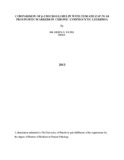| dc.description.abstract | Background information: Chronic lymphocytic leukemia (CLL) is a lymphoproliferative
disorder of variable clinical course. Some patients do not need any treatment during the course of
the disease, but some need intensive treatment. Clinical staging is used for prognosis and to
initiate treatment, but it cannot identify patients who will run an indolent course or who will run
progressive disease. There are prognostic markers, which can be used to identify patients who
would benefit from early initiation of therapy irrespective of clinical stage. Elevated β-2
Microglobulin (B2M) and lactate dehydrogenase (LDH), expression of CD38 and ZAP-70 are
markers associated with poor prognosis in CLL. B2M and LDH are inexpensive, affordable tests,
while ZAP-70 and CD38 are expensive tests.
Objective: To compare β-2 Microglobulin with CD38 and ZAP-70 as prognostic markers for
CLL and a secondary objective was to compare LDH with CD38 and ZAP 70 as prognostic
markers.
Study design: A cross-sectional comparative descriptive study.
Setting: Thirty five (35) patients were recruited from Kenyatta National Hospital (KNH)
hematology clinic and medical wards; ten (10) patients were sourced from hematologists clinic
from the Aga khan University hospital (AKUHN) and the MP Shah hospital.
Subjects: Forty-five participants diagnosed with CLL, on the basis of persistent lymphocytosis
and peripheral blood morphology were enrolled in this study. The diagnosis was made as per
International workshop of chronic lymphocytic leukemia (IWCLL) (2008) guidelines, which
requires the presence of persistent lymphocytosis (in excess of 3 months) of at least 5 x 109 B
lymphocytes/L (5000/μL) in the peripheral blood.
Methodology: Forty-five (45) eligible participants who were diagnosed with CLL were enrolled
into the study. Clinical information as well as relevant laboratory test results at the time of
diagnosis for Binet staging was extracted from the patient’s records. Clinical features utilized in
staging including the presence of lymph node enlargement, splenomegaly and hepatomegaly
xi
were recorded into predesigned data extraction sheets. Four milliliter of venous blood was
collected in ethylene diamine tetra acetic acid (EDTA) vacutainer and analysed for full blood
counts, as well as CD38 and ZAP-70 expression at AKUHN laboratory. Another four milliliter
of venous blood was collected in a plain tube. The serum was separated into a cryovial and
frozen at -20°C at unit of clinical chemistry. B2M, LDH and creatinine were assayed in batches
at university of Nairobi (UON) clinical chemistry laboratory at KNH using the above thawed
serum sample.
Data was collected using the structured questionnaire, and a pre-designed data sheet. Data was
entered into MS access database, cleaned and imported into STATA v.12 for analysis.
Sensitivity, specificity and Kappa statistics were calculated.
Results: Forty-five eligible patients with the diagnosis of CLL were enrolled into the study. The
median age was 62 years with a male to female ratio of 1:1. Twenty three (51%) patients were
stage C of Binet staging. Twenty seven (60%) participants expressed ZAP-70, twenty two (49%)
participants expressed CD38, thirty five (78%) participants had elevated B2M levels and twenty
six (58%) participants had elevated LDH levels. When the comparison tests were done, there was
poor concordance between B2M with ZAP-70 (k=0.0), CD38 (k=0.07) and LDH (k=0.02). There
was marginal concordance between LDH with ZAP-70 (k=0.12) & poor concordance with CD38
(k= -0.06). The sensitivity of B2M when compared with ZAP 70 was 77.8% and CD38 was
81.8%. The specificity of B2M when compared with ZAP 70 was 22.2% and CD38 was 26.1%.
The sensitivity of ZAP-70 was 65% when compared with LDH. Only mean CD 38 correlated
with Binet staging (p=0.021), but there was no correlation when Binet stage A, B and C was
compared with the positive and negative values of ZAP-70, B2M, LDH and ZAP-70/CD38
combinations.
Conclusion: There was poor correlation between B2M levels with CD38 as well as ZAP-70
expression. There was also poor correlation of LDH levels with CD38, ZAP-70 expression and
B2M levels. Therefore B2M is not a suitable substitute for CD38 and ZAP-70 in prognostication
of CLL. In addition LDH similarly is not a suitable substitute for CD38 and ZAP-70 as
prognostic markers.
xii
Recommendations:
According to this study the inexpensive B2M and LDH levels are inappropriate substitutes for
ZAP-70 and CD38 expression in prognostication of CLL. A limitation in this study is the sample
size due to budgetary and time limitations. A prospective study with a larger sample size is
recommended. | en |

